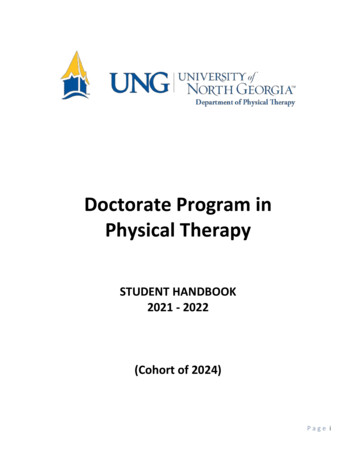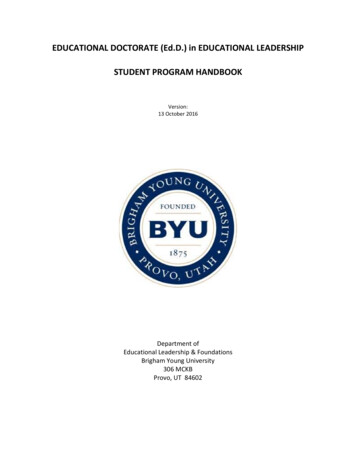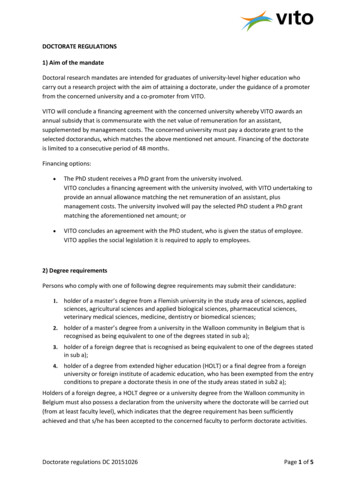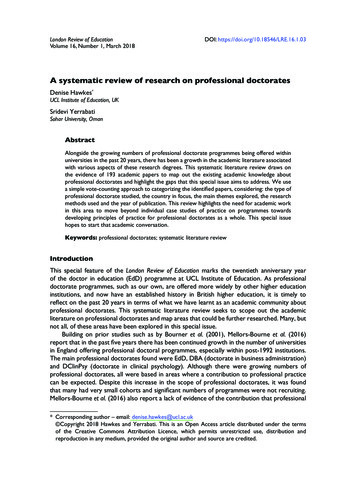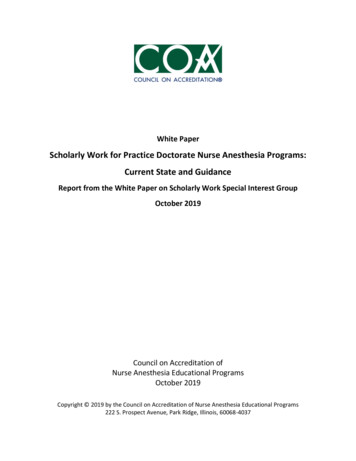
Transcription
White PaperScholarly Work for Practice Doctorate Nurse Anesthesia Programs:Current State and GuidanceReport from the White Paper on Scholarly Work Special Interest GroupOctober 2019Council on Accreditation ofNurse Anesthesia Educational ProgramsOctober 2019Copyright 2019 by the Council on Accreditation of Nurse Anesthesia Educational Programs222 S. Prospect Avenue, Park Ridge, Illinois, 60068-4037
2Table of ContentsExecutive Summary 3I.II.44III.IV.V.VI.VII.VIII.IX.Background Current State of Scholarly Work .SurveyResultsAANA Foundation Session and COA Focus GroupHighlights of AANA Foundation SessionHighlights of COA Focus GroupScholarly Work Guidance and Recommendations .CRNA Faculty Oversight of Scholarly WorkTitle: “Scholarly Project”Elements of Scholarly WorkIdentifySearch, analyze, synthesizeLiterature reviewsDevelopPlan for ImplementationProject example with implementationProject example without implementationEvaluation of Scholarly ProjectDissemination of Scholarly ProjectTeam ProjectsAcademic PortfoliosOriginal ResearchResourcesFaculty Rank and PromotionFuture Scholarly Work .Literature and Scholarly Work .Other Practice Doctorates .Summary .Appendix A – Definitions Regarding Scholarly WorkTables1. Types of Scholarly Work (Project) Required2. Methods of Dissemination3. Group Project Evaluation Methods4. Other Practice DoctoratesReferences .Acknowledgements .a. White Paper on Scholarly Work Special Interest Group (SIG)9121213132830
3Executive SummaryThe Standards for Accreditation of Nurse Anesthesia Programs: Practice Doctorate was adopted by theCouncil on Accreditation of Nurse Anesthesia Educational Programs (COA) in January 2015. Balancingacademic and clinical preparation for doctoral students, preparation for the National CertificationExamination, and scholarly work represents a significant challenge for students, faculty and programs.With the majority of nurse anesthesia programs having transitioned to the practice doctorate, the COAwas in a pivotal position to 1) examine the current state of scholarly work and 2) produce a White Paperto guide programs’ development of criteria for scholarly work as defined in the Standards forAccreditation of Nurse Anesthesia Programs: Practice Doctorate (COA, 2018).To inform the guidance contained in this White Paper, nurse anesthesia educators provided input via asurvey, a focus group at the 2019 Assembly of Didactic and Clinical Educators meeting, and an activediscussion and question-answer session during the assembly. Survey data along with highlights of thefocus session and the discussion and question-answer session are included. A Call for Comments wasalso sent to stakeholders for review and comment on the draft White Paper.The survey data and educator input formed the foundation for the guidance recommended forprograms regarding scholarly work. Guidance regarding titling the work and key elements include:problem identification, searching and analyzing the literature, developing a strategy to address theproblem, implementing the strategy, evaluating the doctoral project and disseminating the doctoralproject.This White Paper also addresses topics such as the use of student teams to complete the scholarly work,literature reviews, academic portfolios, original research, resources and implications of participation onstudent projects for faculty workload, and meeting professional rank and tenure requirements.Recommendations for future scholarly work along with pertinent literature and a comparison ofscholarly work required for other practice doctorates are included.The guidance set forth in the White Paper in no way supersedes institutional and/or other accreditorrequirements. The aim of this guidance is to aid nurse anesthesia programs in successfully managingscholarly project curriculum.
4I. BackgroundThe Standards for Accreditation of Nurse Anesthesia Programs: Practice Doctorate was adopted by theCouncil on Accreditation of Nurse Anesthesia Educational Programs (COA) in January 2015.A challenge for nurse anesthesia educational programs awarding practice doctorate degrees for entryinto practice is ensuring that there is an appropriate balance of scholarly work and academic/clinicaleducation requirements for students. Programs aim to formulate curricula which underscore the goal ofgraduating students who have acquired entry-into-practice competencies, upon which nurseanesthetists continue to build their knowledge, skills and abilities along the practice continuumbeginning at graduation (proficient) and continuing throughout their entire professional careers (expert)(COA, 2018). Nurse anesthesia educational programs require complex didactic academic coursework anda minimum of 2,000 hours of clinical training, during which students must also prepare for the NationalCertification Examination (NCE). The implementation of a meaningful scholarly project in the context ofthis rigorous educational milieu imposes challenges on both students and faculty.At its October 2018 meeting, the COA finalized the appointment of the White Paper on Scholarly WorkSpecial Interest Group (SIG) to examine the wide variation in types of scholarly projects as well asproject rigor. This was in response to requests from nurse anesthesia programs for the COA to provideguidance in the requirements for scholarly projects. The standards related to scholarly work and thecorresponding glossary definitions for scholarly work and scholarship skills are included in Appendix A tothis White Paper (COA, 2018). The charges of the SIG included: 1) survey programs to identify thecurrent state of scholarly work in doctoral-level nurse anesthesia programs, and investigate therequirements and scholarly work of other disciplines that award a practice doctorate, and 2) produce aWhite Paper to guide programs’ development of criteria for scholarly work as defined in the Standardsfor Accreditation of Nurse Anesthesia Programs: Practice Doctorate. Standards that apply to scholarlywork include Standard D. Graduate Standards (Professional Role) and Standard E. Curriculum Standards(Research).II. Current State of Scholarly WorkIn November 2018, a survey instrument was developed by the SIG. The purpose of the survey was toidentify the current state of scholarly work for nurse anesthesia programs approved to offer practicedoctorates. Prior to emailing the survey link, the survey was vetted by the Louisiana State UniversityHealth Sciences Center Institutional Review Board (IRB) to assure human subject protections forparticipants. It was determined that no approval was needed as long as responses and participants werekept confidential and anonymous. Preliminary survey results were presented to participants at theFebruary 2019 Assembly of Didactic and Clinical Educators (ADCE) meeting, resulting in an activediscussion and question-answer session. A faculty focus group session was also held at the samemeeting. The focus group addressed key items including the vision for scholarly work, examples ofscholarly work and examples of what is not considered to represent scholarly work in practice doctorateprograms. Lastly, a Call for Comments survey addressing the White Paper draft was sent to programadministrators, deans, and members of the AANA and NBCRNA Boards of Directors.
5The purpose of this White Paper is two-fold: 1) to provide results from the survey and focus sessionfrom which educators can observe the common issues and struggles faced by students, faculty andprograms, and to propose some solutions, and 2) to offer guidance to programs about what scholarlywork may look like in nurse anesthesia programs. The guidance does not represent mandates orrequirements by the COA, but rather provides clarification that may be beneficial to programs.SurveyThe initial survey was sent to all programs offering an entry-level doctorate or completion degreeprogram for CRNAs (89 programs) on January 15, 2019 with a follow-up on January 22, 2019. The surveyclosed on January 30, 2019. An impressive 51 (57%) programs responded to the survey.Results Responses were reported by 34 (67%) programs in schools or colleges of nursing and 17 (33%)housed in other units (Colleges of Health Sciences, Health Professions, Biology; Schools ofMedicine; Colleges of Business: Healthcare Administration and Management; Schools of NaturalSciences, Mathematics, and Computing; and Graduate Studies).Evidence-based practice projects (Table 1) were the primary type of scholarly work offered bythe respondents. A few programs required original, retrospective and IRB-approved research (24%); practice change initiatives (4-8%); a portfolio (1-2%); or a literature review (1-2%). Fortyone (80%) of the programs reported they had flexibility in designing the scholarly work projectwhile 10 (20%) did not (the project criteria are controlled by the parent organization).An implementation component of scholarly work was required by 38 (75%) programs, whiledissemination was required by nearly all programs (98%). Dissemination methods were varied(Table 2). The methods reflected program, college and/or university requirements. While therewere 50 responses in total regarding dissemination, there were multiple responses by someprograms.Programs reported that the number of faculty needed to support scholarly projects ranged from1-12 (mean 2.4). The data however did not account for full- or part-time faculty status. Peracademic year, an average of six projects per faculty member were reported (range 2-18).Doctoral degree credentials were required for faculty participating in scholarly work (DNP,DNAP, DNSc, EdD, PhD, MD). Faculty contact hours in support of scholarly projects were a meanof 61, a maximum of 400, and mode of 30-40 hours.Initial approval for a proposed project was completed by committees (36); individuals (11); orother course-assigned faculty members. Final approval for projects included committees (39);individuals (8); or other (4) methods including department or program chair or course faculty.Individual and team project composition was reported by programs. Student team size rangedfrom 2-4 students. Some teams were self-selected. Variables for the team size included the typeand complexity of the project, scope, learning outcomes, mission, interprofessionalcollaboration, and the number of students at clinical sites. Team project evaluation methodsvaried (Table 3). There was a total of 28 responses to this item; some programs offered multipleresponses.Eighteen (35%) of the respondents shared that participation in scholarly projects had an impacton rank and tenure of faculty. Colleges and universities differ regarding how faculty who mentorscholarly work receive credit. Faculty may receive credit for teaching, scholarship and/or service.
6AANA Foundation Session and COA Focus GroupThe AANA Foundation held a general session at the February 2019 ADCE to discuss scholarly workprojects. Shari Burns, EdD, MSN, CRNA, chair of the SIG, facilitated the session which lasted more thantwo hours and yielded an abundance of feedback from program administrators and faculty. There wereapproximately 200 participants.The 90-minute faculty focus group session was facilitated by the COA on the day after the AANAFoundation session. The focus session was open to all faculty attending the ADCE. More than 50participants attended the session. The COA definitions of scholarly work and scholarship skills werediscussed (COA, 2108). Both the general session and the focus session yielded substantive feedback fordevelopment of this White Paper. While the response rate to the survey was excellent due to the largenumber of attendees at the ADCE, additional rich data was acquired from the sessions.Highlights of AANA Foundation SessionThe Foundation session included a substantive discussion covering multiple topics.Some nurse anesthesia educational programs assign topics to their students while other programs allowstudents to select topics. Programs that allow student selection cited the desire to develop leaders andproblem-solvers while nurturing skillsets highlighting creativity and analysis. Educators speculated thatthe doctoral degree was just the beginning of a career and raised the question, “What should studentstake away from the practice doctorate?”Creating future leaders with skills to address clinical problems requiring change represented anapproach to better understanding the aim and scope of practice doctorate scholarly work. For example,identifying a clinical issue, searching the literature, coming up with viable solutions and presenting theinformation in an executive summary offers one approach.Programs with strong resources continue to undertake collaborative work with bench researchapproaches to scholarly work.Some programs are prescriptive while other programs offer latitude in the project type, scope and topicselection.Multiple programs described extending a project over more than one cohort; that is, students or teamsin subsequent classes might continue to pursue the aims or goals of the project.Programs seemed uniformly concerned about overcrowding clinical sites with scholarly work projects.However, clinical sites indicated that they value these projects.The IRB submission process poses challenges. Some universities and/or programs, as well as hospitals,require all projects to be submitted to the IRB. Work overload for all stakeholders is a consideration.Some programs struggle with submission of quality improvement (QI) projects to IRBs which may beunfamiliar with QI projects. Other programs struggle to determine whether QI projects need IRBapproval.Project writing presents challenges, as entering undergraduate students may have insufficient writingskills. Editorial work can be burdensome for faculty. Some programs hire editors or use writing resourcesin the community or institution to assist with the burden.
7Some programs mentioned that the Standards for Quality Improvement Reporting Excellence (SQUIRE)Guidelines are used as guidance for projects. These writing guidelines, first published in 2008, offerguidance to improve the accuracy and clarity of written reports on the quality and safety of healthcare(Davies, Batalden, Davidoff, Stevens and Ogrinc, 2015; Goodman et al., 2016).Other barriers to scholarly project work reported by the attendees include misaligned expectations byPhD, EdD, DNP and DNAP faculty. For example, the opinion was expressed that a “140-page dissertationtype” project does not match the purpose of scholarly work for a practice doctorate.For entry-level programs, balancing academics and clinical education remains a challenge. Spendingtime on scholarly work rather than studying for the NCE was underscored. Taking students out of clinicaleducation to work on projects created concern for educators. Creating a “practice scholar” through thepractice doctorate remains the goal.The use of portfolios was raised. The suitability of portfolios containing some of the evidence developedby the scholarly project was compared to portfolios containing only curricular items (e.g., papersunrelated to the scholarly project, journals, clinical case numbers).Other ideas were offered such as pairing an SRNA with a completion degree CRNA. Both may benefitfrom such teamwork.Highlights of COA Focus GroupThe COA focus group explored 3 questions:1. What is the vision for scholarly work (projects)?The practice doctorate results in a skilled clinician, but also represents a graduate who isprepared to use scholarly work skills, leadership and teamwork to advance practice. Scholarlywork skills include problem identification; seeking, applying, appraising and translatingevidence; determining strategies for change; creating new policies and procedures;implementing such changes (if feasible); and sharing (disseminating) the scholarly work productswith others.The evidence-based process informs and improves clinical and educational practice. The skillsetderived from the process is as important as the product. Inspiring students to use the skillsetfollowing graduation is key to promoting future scholarly work as clinicians.The required scholarly work should involve reasonable scope and time commitment in thecontext of practice doctorate nurse anesthesia educational programs, be achievable, and informpractice. Including teams to address gaps in practice and clinical or educational issues fostersleadership development while moving through the scholarly work process. Teamwork isfoundational to anesthesia practice.2. What key elements should be included in scholarly work?Although the key elements identified by the focus group mirrored the choices offered in thesurvey, the group discussion provided additional insights. Project types may vary, but thefollowing elements were identified as significant to all scholarly work.
8 Problem identification (clinical, educational, professional)Retrieval, review and analysis of existing evidence from the literatureDeveloping a strategy to address the problemImplementation (actual vs simulated): Because of the breadth and scope of some projects,not all projects may be implemented. This is particularly true for projects aimed at changesin practice, educational strategies, or administrative policies. While the student maygenerate the underpinnings of change based on evidence and analyses, executing thechange may continue well past the student’s graduation. Later student cohorts mayimplement changes suggested in the initial scholarly work.Dissemination in some form (COA requirement)Dissemination Options Continuing education offeringPosterSubmission for publicationExecutive summaryInstitutional requirementsOral defenseExamples of Final Project Types Final PaperPublication-ready manuscriptPlatform presentation (national, state, local meeting)Virtual presentation3. What is an example of something that would not be a key element of a scholarly work?An example of what would not be a key element of scholarly work is a literature review thatlacks applicability to affect practice improvement. In contrast, a review of the literature inclusiveof an appraisal with implications and/or recommendations for practice offers greater breadth,depth and scope. One student may undertake and complete such a review; a follow-up studentmay then use the reviewing the work for policy development.III. Scholarly Work Guidance and RecommendationsBased on the work of the SIG, the COA puts forth the following guidance. Scholarly work is specificallylinked to the definitions of Scholarly Work and Scholarship Skills (Appendix A) contained in the COAStandards.CRNA Faculty Oversight of Scholarly WorkWhile CRNA and non-CRNA faculty involvement in the scholarly work development process may varydepending on the project scope or on the requirements of the institution, college/school or program,faculty with a CRNA credential must be involved in the process of planning, formation and evaluation ofeach scholarly project.
9Title: “Scholarly Project”The term dissertation conveys research-oriented work consistent with PhD and EdD degrees. The termcapstone is used in high school and middle school, or at the end of an academic program.The title “Scholarly Project” speaks to the unique application of work required to attain the practicedoctorate. Using terminology consistent with the degree focus is recommended, i.e. DNP project, DNAPproject, scholarly project.Elements of Scholarly WorkTo satisfy the requirements of practice doctorate training, scholarly work represents an evidence-basedinquiry process using scholarship skills resulting in an academically sound product to improve clinicalpractice. Original research is typically reserved for research doctorates; however, some programs mayrequire original research.The scholarly work for students in a nurse anesthesia program that awards a practice doctorate shouldinclude the following steps: Identify a problem related to nurse anesthesia practice (clinical, educational, professional).Search, analyze and synthesize existing evidence (literature search skills and critical thinking).Literature reviews are a requirement for all projects. A review of the literature inclusive of anappraisal with implications and/or recommendations for practice offers breadth, depth andscope to a project. For example, a student may complete a literature review, analysis andsynthesis focused on CRNA involvement in professional associations. Another student mayaddress this same topic focusing on state policy development. Stand-alone literature reviewswithout analysis serve as a platform for a project but fall short of the other elements of scholarlywork.Develop a strategy or method to address the problem (demonstrating problem solving andcritical thinking).Plan for Implementation of the strategy or method to be used to address the problem. It isacknowledged that not all projects can be implemented due to breadth or scope. For example,projects aimed at changing practice, educational strategies or administrative policies may not beimplementable because of their breadth or scope, yet they still have value as an initialexamination and analysis of a problem. Therefore, while the student may generate thefoundations of change based on evidence and analyses and propose methods for implementingthe change, executing the change may require time, resources and committee approvals wellpast the student’s graduation. As evidenced by the SIG survey, foundation session, focus group,and Call for Comments survey, scholarly projects can be extremely varied.Project example with implementation1. Registered nurses may lack knowledge and training regarding malignant hyperthermiaprotocols throughout a multi-facility hospital system. Administration of a pre-test todetermine baseline knowledge would precede an in-service education program; followingthe in-service a post-test to evaluate gains in knowledge would form the foundation of theproject. Implementation of new educational requirements result.2. Implementing oral didactic testing in an entry-level nurse anesthesia educational programmay be initiated based on a project dedicated to testing comparisons.
10 Project example without implementation1. Issue: Improving patient safety by changing current monitoring practices for patientsreceiving peripheral nerve blocks (PNBs). To address this issue a student may search for,analyze and apply evidence to create a hospital policy for patients receiving PNBs. However,implementing the policy requires multiple levels of approval as well as staff education. Timeconstraints of the entry-level or completion-degree CRNA may preclude fullimplementation.2. Projects with a very large scope may be extended from one cohort to the next. It may not befeasible to implement the initial project. Narrowing the scope of the project is advisable, butis not always feasible depending on the project topic.Evaluation of Scholarly ProjectEvaluation of scholarly work may include a combination of methods including faculty, expert and/orpeer evaluation. Programs tailor scholarly work evaluation and approval processes per university,department, program or committee requirements.Dissemination of Scholarly Project (COA Required)Dissemination of rigorous scholarly work contributes to the profession. Dissemination methods dependon the program or institution and may include a combination of methods. Dissemination includes a finalwritten product that is presented to stakeholders at the university or at a local, state or nationalmeeting. Other methods for disseminating the scholarly product to multiple stakeholders may include:poster presentations; manuscript under review and/or submission for publication; in-service education;or podcasts.Consider avoiding the term ‘defense’ in the final presentation of a completed practice doctorate project.The term is commonly applied to approval for the research-oriented doctorate.Team ProjectsSome programs faced with an ever-increasing number of projects are opting to incorporate themultifaceted engagement of a team approach to complete scholarly work. Through this approach,students can gain essential teamwork skills. For faculty members, a major benefit of the team approachis a reduced number of projects they must oversee; likewise, survey and project fatigue may be lessenedfor all involved, including survey recipients. The team approach also helps address concerns expressedby clinical site coordinators about the potential for scholarly work to take away from clinical activities.Clinical sites can be overwhelmed with multiple on-going projects.A clear delineation of requirements for team projects is recommended. Some programs alsorecommend the use of learning contracts for team members wherein the team members delineateresponsibilities for the project. Team composition may vary by project requirements and institutionalneeds. For CRNAs completing a practice doctorate, interprofessional collaboration may beadvantageous. The American Association of Colleges of Nursing (AACN) published guidance regardingteamwork in the DNP Tool-kit (2019).
11Academic PortfoliosAcademic Portfolios chronicle student accomplishments throughout the program which may includescholarly work, student papers, case numbers, reflections, presentations, etc. Scholarly work may beincluded in the portfolio. If used as a project tool, portfolios are useful for organizing material andallowing students to view the scope of their topics. The portfolio should be a tool to enhance thepresentation and understanding of a project, but not be considered the sole deliverable product of theproject.Original ResearchResearch to develop new knowledge is historically viewed as work within the PhD domain, andtherefore is not viewed as a requirement for the practice doctorate scholarly project. Programs mayprovide this as an option for exceptionally motivated students, but requiring original research is notnecessarily consistent with the aim of the practice doctorate.ResourcesScholarly projects require faculty input as a source of expert guidance and oversight. Faculty workloadinclusive with teaching, clinical practice, community service, and scholarship pose challenges; mentoringscholarly projects adds to the already heavy workload. A significant component of faculty workload,mentoring scholarly projects is essential to the practice doctorate curriculum for the program. Programsshould consider this academic workload when planning practice doctorate education to ensure hiring anadequate number of faculty with the appropriate background to meet this need.Faculty Rank and PromotionFaculty participation in doctoral projects in many institutions is considered scholarship, teaching and/orservice. The diversity of approaches to awarding promotions, rank and/or tenure to faculty based ontheir work in scholarly projects can be beneficial.IV. Future Scholarly WorkSuggestions for assessing and evaluating how the evolving nature of practice doctorate projects mayimpact the practice of nurse anesthesia include the following:1. Survey CRNAs with practice doctorates to determine how scholarly work influences theirpractice.2. Survey practice-doctorate CRNAs to determine how they are using scholarly work skills postgraduation.V. Literature and Scholarly WorkKirkpatrick and Weaver (2013) reported on dialogue regarding DNP projects that took place amongparticipants at the Committee on Institutional Collaboration DNP Invitational Conference. The focus ofthe dialogue was to discuss the DNP project’s intent and breadth, demonstration of competencies, andsimilarities and differences to the PhD dissertation. One question asked was related to the value of thetime and energy expended by faculty on the DNP project. In responding to this question, the groupnoted the following benefits for faculty:
12 Recognition resulting from product disseminationMatching project topics with faculty interest and expertiseStudent mentorship (meets an expectation of faculty role)Contribution of project to scholarship (meets an expectation of faculty role)The literature regarding faculty workload when supervising graduate nursing students’ DNP projects islimited. Lobo and Liesveld (2012) conducted a study to describe workload assignments for graduatenursing faculty supervising both research and advanced clinical nursing students. A survey was sent to617 nursing school administrators via email and the response rate was 126 (26%). Of the 36administrators who responded to a question about whether they give workload credit for DNP projectsupervision, 22 (61%) confirmed that they did.Sebastian and Delaney (2013) examined opportunities for faculty teaching in DNP Programs noting thatDNP faculty may need different strategies for teaching, scholarship and service due to the focus ontranslation of science into practice. The authors noted that roles for DNP faculty align with the broaderconceptualizations of scholarship consistent with the Boyer Model (Boyer, 1990; Boyd, 2013). Theexpanded view of the Boyer Model (scholarship of discovery, integration, application, and teaching andLearning) was evidenced in a rank and tenure analysis for faculty (Crow et al. 2018). The relevance ofthe Boyer Model for faculty charged with mentoring scholarly projects underscores that universities andcolleges consider all forms of scholarship for faculty advancement. Further, “promotion and tenurepolicies should accommodate newer forms of scholarship if DNP prepared faculty are on tenure tracks”(Sebastian and Delaney, 2013, p. 454).In a
Accreditation of Nurse Anesthesia Programs: Practice Doctorate (COA, 2018). To inform the guidance contained in this White Paper, nurse anesthesia educators provided input via a survey, a focus group at the 2019 Assembly of Didactic and Clinical Educators meeting, and an active discussion and question-answer session during the assembly.







